Last Updated on March 15, 2025 by Owen McGab Enaohwo
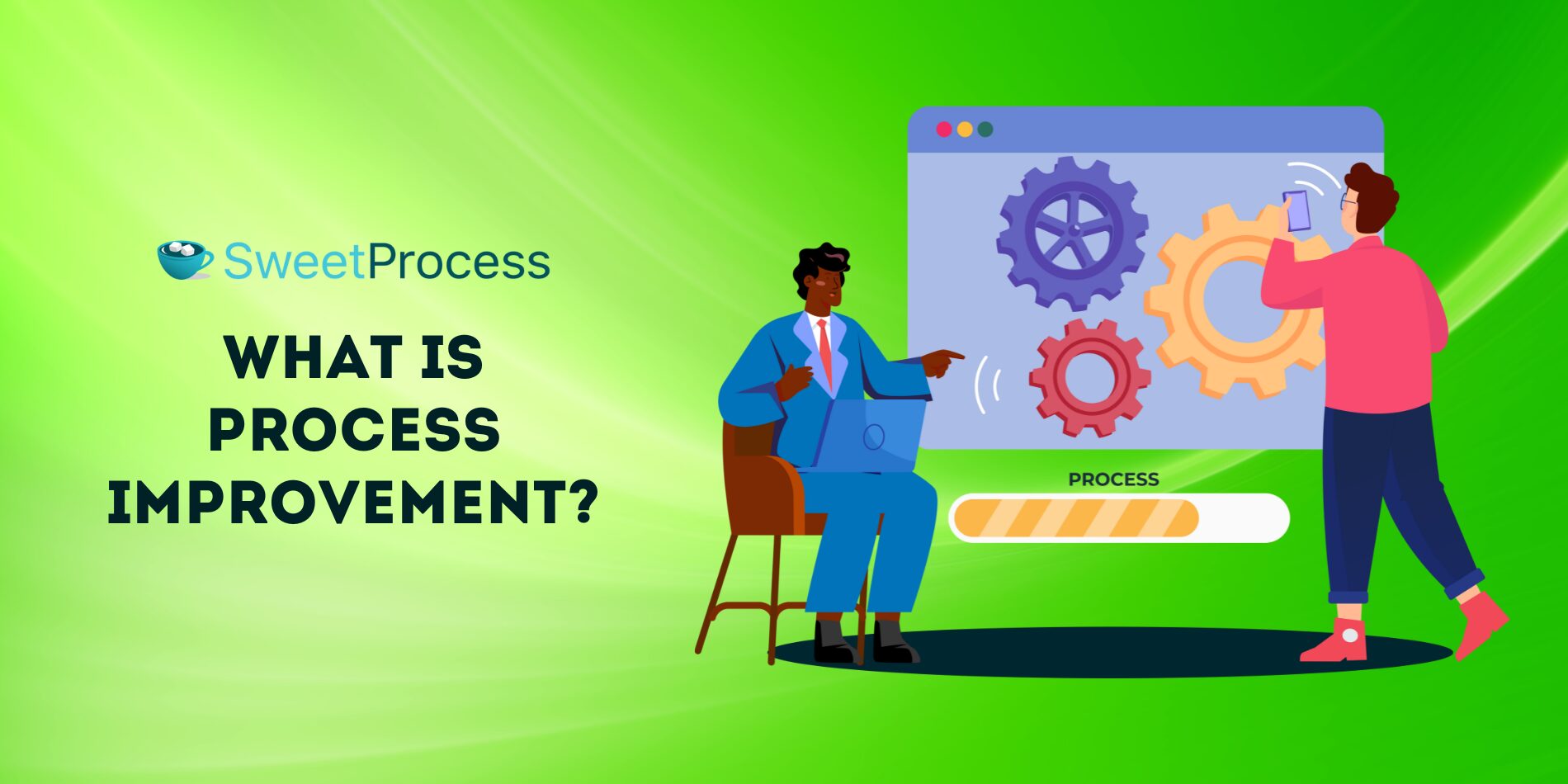
Think about your organization’s day-to-day operations. How much time is wasted on tasks that could be automated or processes that feel more like obstacles instead of solutions?
Although every business strives to run smoothly, inefficiencies can creep in. Maybe your team is working hard, but progress feels slow, and you can’t seem to pinpoint the problem.
You’re constantly putting out fires—dealing with repeated errors, delays, or unproductive routines. These everyday frustrations result from inefficient processes—issues that silently drain your business of time and money. If left unaddressed, they lead to lost opportunities and a frustrated team that feels stuck.
These are clear signs that your processes need an overhaul. But where do you start? And how do you ensure changes stick?
In this guide, we’ll break down the concept of process improvement and show you how implementing it can transform your organization.
Don’t let inefficiencies drag your business down. Sign up for a free 14-day trial of SweetProcess today and start building workflows that work for you.
What You’ll Learn In This Guide:
11 Benefits of Process Improvement in a Business
How to Implement Process Improvement in Your Organization
How to Improve Your Company’s Business Processes Using SweetProcess
7 Process Improvement Examples You Can Implement in Your Business
12 Process Improvement Methodologies
10 Drawbacks of Process Improvement to Avoid
Improve Your Company’s Processes Using SweetProcess
What Is Process Improvement?
Process improvement involves analyzing, refining, and optimizing a company’s workflows to make them more efficient and effective. The primary objective of process improvement is to eliminate waste and implement solutions that help you achieve better outcomes.
Since this process is continuous, this task should be implemented throughout. Process improvement typically focuses on the following:
- Reducing unnecessary steps in workflows
- Streamlining communication and collaboration
- Automating repetitive tasks
- Enhancing quality and consistency in outputs
- Ensuring compliance with industry standards and regulations
It should be applied to all departments — whether streamlining customer service responses, improving manufacturing workflows, or enhancing administrative operations. This way, your company will achieve success in all areas.
11 Benefits of Process Improvement in a Business

Improving business processes comes with several benefits. Here are some of them:
Improved Efficiency
As mentioned, inefficient processes take up a lot of time and resources. For instance, if your business relies on manual processes to manage projects and approvals, your team will wait longer for email chains.
However, if the process is automated on a centralized platform, approvals are done much quicker, and you’ll have faster feedback loops, providing more time for strategic work. Continuously improving your business process ensures that your team operates at peak performance by spending less time on repetitive or redundant tasks.
Cost Management
When was the last time you conducted a business process analysis? Are you spending more money than you should be? Evaluating your company resources regularly helps you identify which business areas are wasting resources.
With this information, you can reallocate budgets and reduce unnecessary expenditures. This can include saving on materials, reducing labor costs, or cutting utility expenses. Cost savings free up funds that can be reinvested into growth initiatives, such as hiring, research, and development, or expanding operations.
Time-Saving
Time is one of the most valuable resources in business. Therefore, inefficient processes lead to significant losses. Process improvement identifies time-consuming bottlenecks and streamlines workflows to save precious hours.
For instance, your HR department can reduce the hiring cycle by adopting an automated recruitment process. Tasks like resume screening, interview scheduling, and feedback collection were handled more efficiently, enabling the team to focus on securing top talent.
Time savings allow your business to scale more effectively and deliver results faster, creating a competitive advantage.
Improved Process Visibility and Performance
Making strategic decisions can be challenging without a clear vision of the process. Process improvement introduces tools and frameworks that make workflows transparent, enabling managers to track performance and make data-driven decisions.
For instance, you can implement business process mapping tools or a monitoring dashboard to identify underperforming areas and take corrective action in real time. With this type of visibility, your business can adapt to challenges quickly, minimizing disruptions.
Regulatory Compliance
According to a survey by Gartner, business leaders are more concerned about how compliance efforts impact company strategy, how to improve third-party risk management, and how to keep up with changing requirements. This is essential because most companies operate under strict industry regulations.
Failing to comply with these standards leads to reputational damage and hefty fines. Process improvement helps businesses standardize workflows and procedures. For instance, you can conduct audits to identify areas your business needs to improve to adhere to legal and industry requirements.
Effective Resource Management
Business owners manage different resources, including labor, materials, finances, and equipment. Over-allocation or underutilization of these resources affects your overall output. However, you can allocate resources only when needed with a proper process management plan or software.
In the long run, this optimized resource allocation reduces costs and enhances productivity, ensuring every task is completed on time.
Quality Management
Customers value consistency. If the quality of your product or service starts to decline, customers might switch to your competitor. This drop in quality often happens when businesses have a weak process improvement structure. Auditing your output can identify defects in manufacturing and allow you to offer more accurate service delivery or better customer experiences.
Your quality assurance team can identify potential risks in production early on and take corrective action.
Improved Customer Satisfaction
Eighty percent of customers value the experience a business provides. The client will be looking at:
- How fast is your service?
- Are your products and services consistent in quality?
- How streamlined is the entire customer service experience?
With a structured process improvement process, you can resolve arising customer issues much faster. Satisfied customers are more likely to drive growth through repeat purchases and word-of-mouth marketing.
Increased Transparency and Alignment
When processes are clearly documented and communicated, teams understand their roles and how their work contributes to overall goals. Everyone knows their responsibility and executes it without any misunderstandings.
The more your team is aligned, the better the collaboration efforts.
Reduced Waste
Waste in a company comes in these forms:
- Overproduction
- Defective products
- Transportation between facilities
- Maintaining inventory
- Overprocessing
- Waiting due to inefficient processes
- Unused talents and unnecessary tasks
Lean process improvement identifies and eliminates this waste, leading to a more efficient organization. Excess processes are removed to optimize the company’s operations and provide value to customers.
Better Results
Continuously improving your processes brings better outcomes across the entire company. Happy customers bring in more customers, increasing sales. In addition, when your resources are optimized, you can be more efficient and save costs, contributing to growth and profitability.
Every step toward refining your processes is a step toward a more efficient, profitable, and successful business.
How to Implement Process Improvement in Your Organization
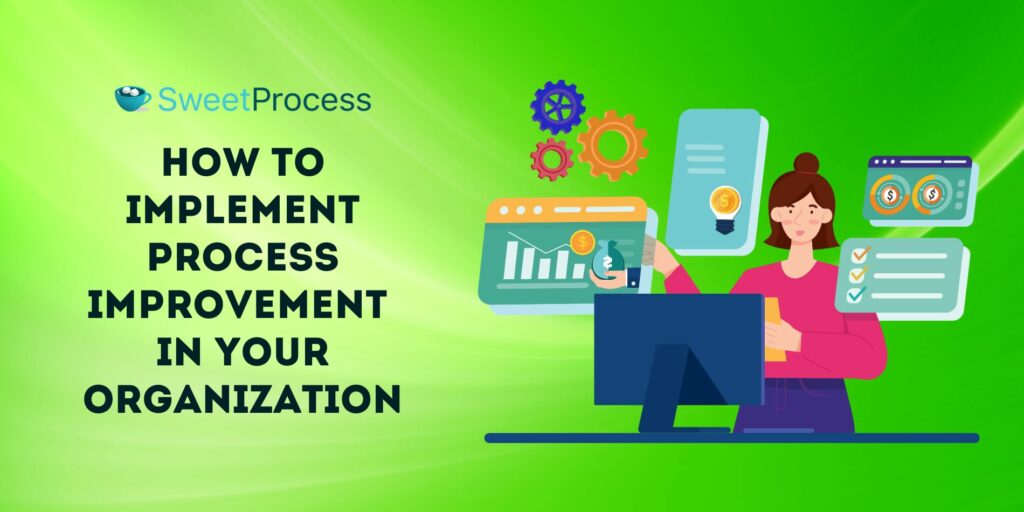
Most businesses fail because they think that process improvement is a one-time task. However, it should be a continuous effort if you want to see tangible results. Let’s break down the key steps you need to follow to implement process improvement:
Identify Your Objectives
Before improving any processes, ask yourself:
- What do you want to achieve?
- Are you aiming to reduce costs, improve quality, increase efficiency, or enhance customer satisfaction?
Objectives provide direction and ensure that every stakeholder understands what the organization is working toward. These goals will set the foundation for your process improvement. For example, if your goal is to reduce costs, you might focus on eliminating waste and automating repetitive tasks.
Map Your Existing Process
Most organizations already have an existing process in place. To implement any improvements, you must first conduct a business process mapping of the current workflow. Creating a visual representation of all your company steps will help you see how your tools work from start to finish.
Process mapping enables you to identify who is responsible for each task, the tools being used, and any dependencies or bottlenecks. This task involves creating flowcharts and diagrams to define your processes clearly.
Mapping your processes creates a comprehensive understanding of how things currently work, making it easier to pinpoint problems and opportunities for improvement.
Identify Areas of Improvement
Once you have a clear picture of all your processes, it’s time to analyze them for inefficiencies. For instance, your HR department might realize that the manual resume screening process is time-consuming. Look for repetitive and outdated processes that contribute to company errors.
To obtain this information, use employee feedback, customer complaints, or data from key performance indicators (KPIs). Tasks that consume the most time or resources but add minimal value are prime candidates for process improvement.
Select a Methodology
While several process improvement methodologies exist, choosing one that aligns with your organization is vital. Start with one that matches your organization’s culture and the complexity of your process. For example, lean is ideal for simple workflows, while Six Sigma suits data-driven environments.
Picking the right methodology ensures that the process improvement efforts are sustainable.
Implement Changes
Once you have the methodology, you can implement your improvement plan. This is the perfect time to test the effectiveness of your plan before full-scale implementation. For instance, you can pilot a new system in one region before expanding to other states. This way, you can address the initial challenges and save time and resources.
Implementing changes methodically to minimize disruptions and ensure the desired outcomes are achieved is good practice.
Create Open Streams of Communication
The biggest mistake business owners and managers make is not communicating with all stakeholders, especially employees, about ongoing company efforts. You need to explain to your team why changes are being made, how they’ll benefit, and what’s expected of them.
For communication to be effective, you need to:
- Share regular updates on the progress of process improvement efforts
- Encourage feedback
- Address concerns promptly
- Hold weekly team meetings to ensure that everyone is aligned
- Use collaborative platforms that streamline communication
Transparent communication builds trust and prevents resistance to change.
Optimize and Repeat
Like any other business activity, you need to improve your processes continuously. Regulations, customer needs, and the market will continue to change, so you must adapt to new challenges or opportunities.
Review processes regularly to identify new inefficiencies or opportunities for improvement. Use employee and customer feedback to refine workflows further.}
Monitor, Measure, and Adjust
The best way to know whether your process is working is to have the necessary measurement and tracking measures in place. Dashboards and reporting tools will monitor performance metrics and ensure accountability. With this data, you can refine your workflows further and adapt them to changing business needs.
Design your KPIs at the beginning and use them to monitor performance. Make the necessary adjustments as soon as you notice the processes are ineffective.
How to Improve Your Company’s Business Processes Using SweetProcess

You can easily document and manage your workflows with the right business tool. SweetProcess is a versatile SOP software that provides a structure to reduce errors, improve efficiency, and create consistency in your teams, making your process improvement seamless. Here’s a guide to improving your company’s business processes using SweetProcess.
Document Your Standard Operating Procedure
The first step to improving any process is documenting it. SOPs standardize workflows and ensure all team members perform tasks consistently. With SweetProcess, you can create clear, detailed SOPs that provide your team with a consistent and reliable guide for completing tasks.
Here’s how:
- Log in to SweetProcess and click on the “Procedures” tab.
- Select “Create Procedure.”

- Give your SOP a clear, descriptive title.
- Add the procedure to teams.

- Add step-by-step instructions, including text, images, and videos, to make the SOP easy to follow.
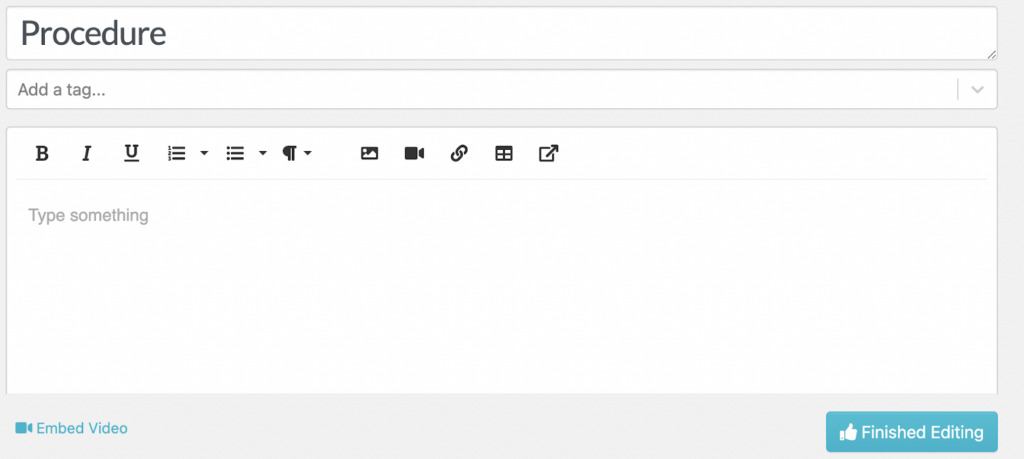
- Click “Finished Editing” and publish your SOP for your team to access immediately.
Alternatively, you can create the SOPs using AI, which takes a few seconds. Once you add a title, click “Write with SweetAI” to draft it.
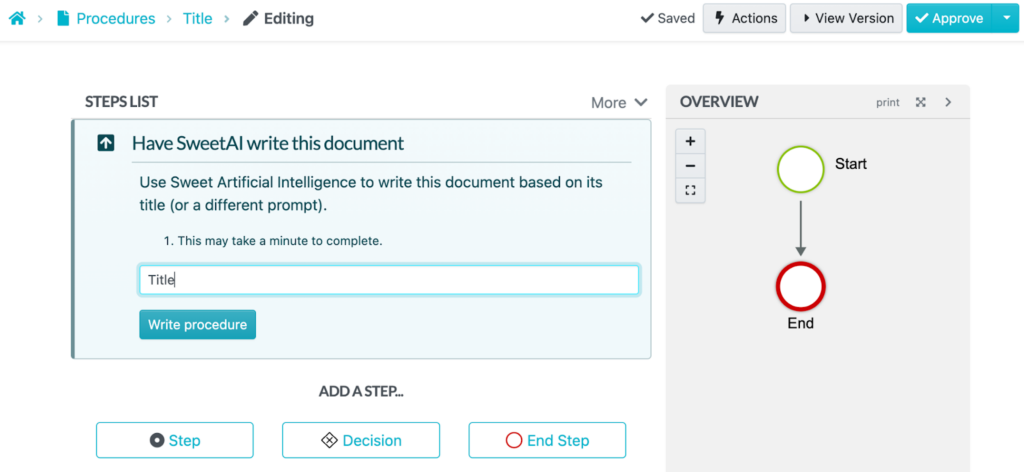
Create a Business Process
Once your SOPs are in place, you can group related procedures into a cohesive business process. This helps organize workflows and ensures they align with your company’s goals.
Here’s how to do it:
- Go to the “Processes” tab and click “Create Process.”

- Name your business process.
- Assign team members responsible for managing and completing the process.
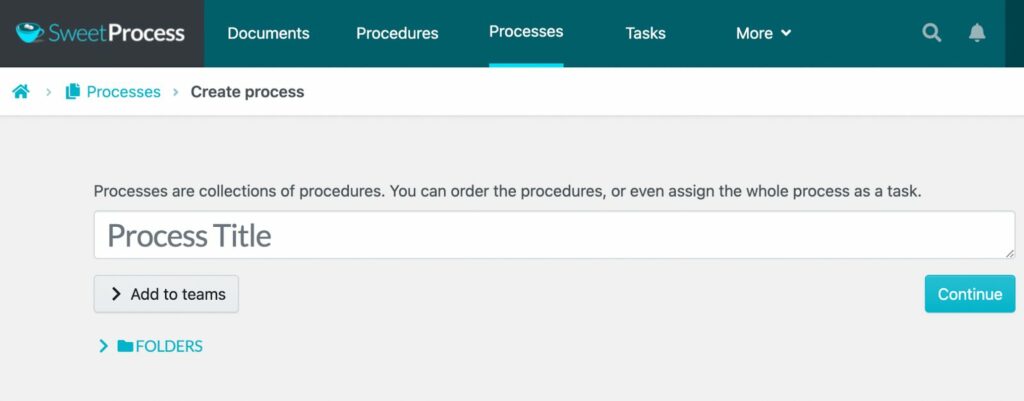
- Add relevant visuals and detailed instructions or notes that provide an overview of the process.
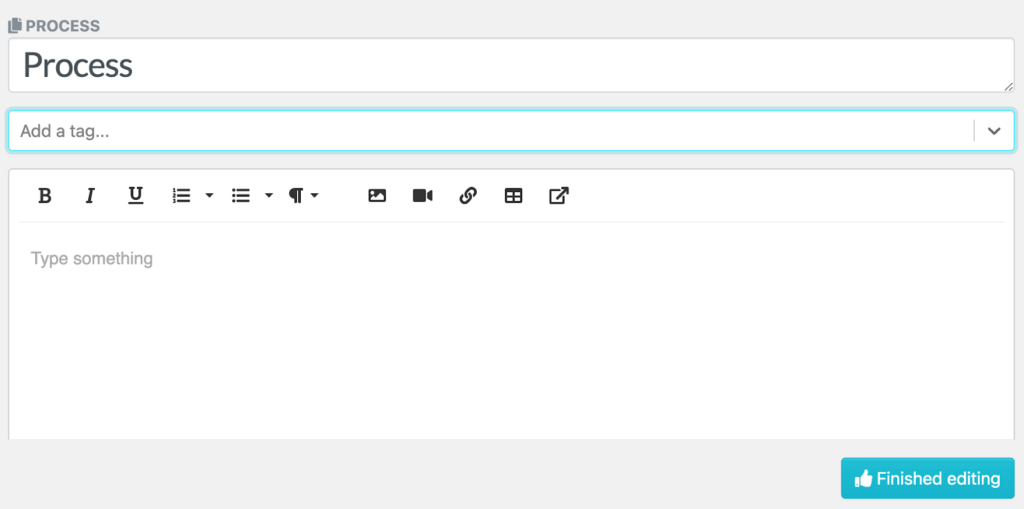
- Save changes and click “Finished Editing.”
Add a Procedure to a Business Process
Once your business process is created, link relevant procedures to streamline execution and provide your team with a step-by-step roadmap. Connecting procedures ensure workflows are easy to follow.
Follow these steps:
- Choose the SOPs you’ve previously created or create a new one.
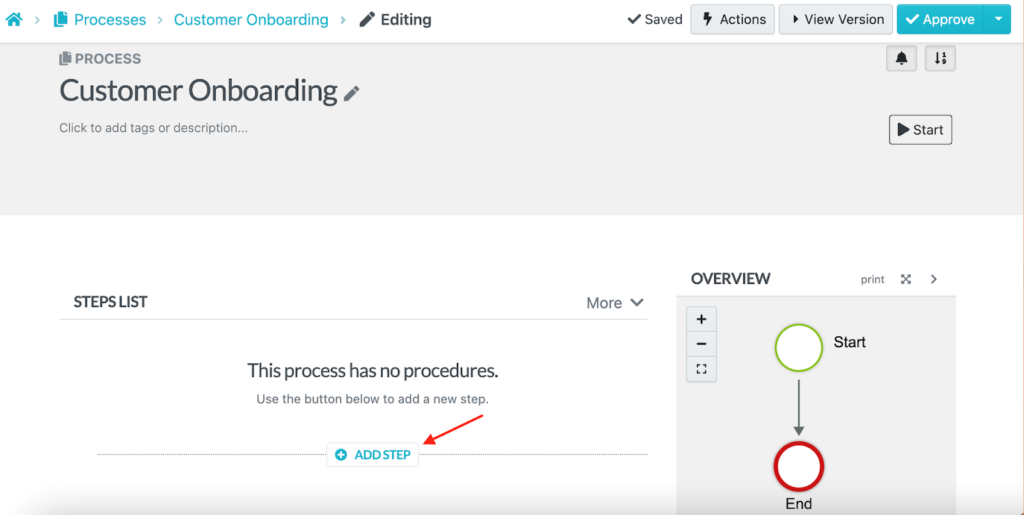
- Add more steps on the next tab. Arrange the procedures in the logical order they should be followed.
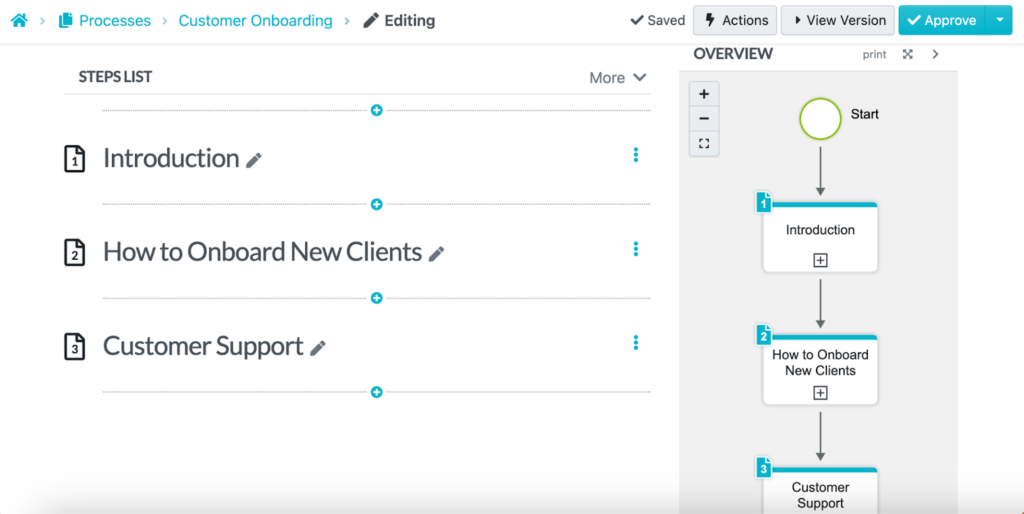
- After adding all the steps, save the changes.
- Share it for approval.

Manage Your Business Process
Managing your business processes ensures they remain effective and up-to-date. SweetProcess makes it simple to oversee, edit, and monitor processes in real time. Here’s how to use SweetProcess:
- Open the “Process” tab.
- Select the specific process you need.
- Pick an action from the pop-up. You can edit, share, assign, or export.
- You can also use the search button to find a specific process.
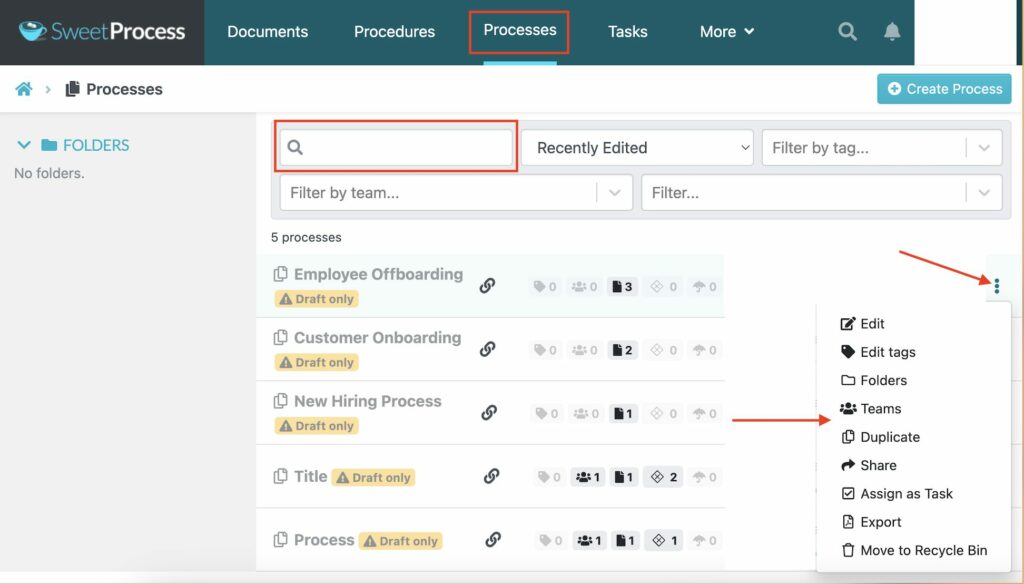
You can monitor progress using SweetProcess’s intuitive dashboards to ensure tasks are completed on time.
View the Version History of a Process
Processes evolve. Having access to version history ensures transparency and accountability. With SweetProcess, you can track every change made to a process.
- Open any process.
- Click on the “Version History” tab. It’s marked using the clock icon.
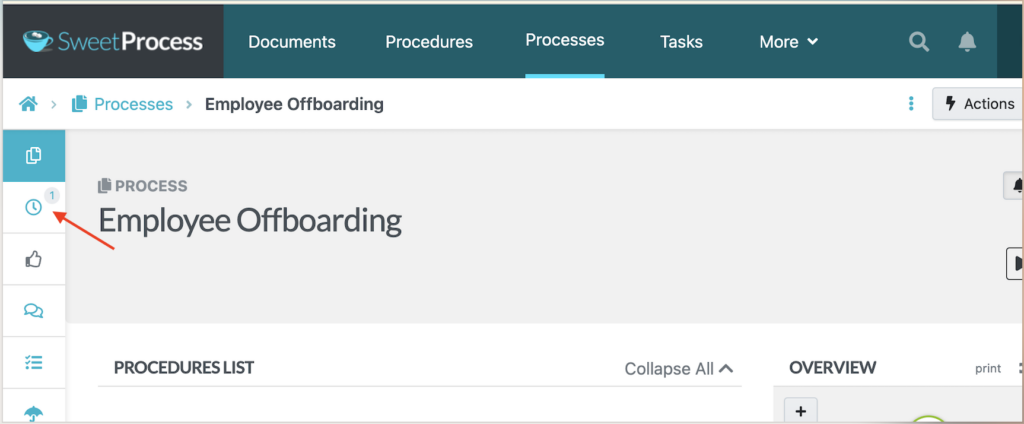
Review previous versions to track edits, updates, and who made the changes. If necessary, you can restore an older version.
Here are some of the small business owners who have used SweetProcess to improve their processes.
TechQuarters is an IT company that helps small and medium-sized businesses transition to cloud-based solutions. However, as the company grew, it faced significant challenges due to a lack of standardized systems and reliance on tribal knowledge. Processes and procedures were documented manually using spreadsheets and word processors, making them difficult to access and update.
TechQuarters’ operations director, Mark O’Dell, recognized the need for a workflow management tool and started searching for checklist software. After sampling several options, he chose SweetProcess due to its flexibility and user-friendly features. The software enabled the company to consolidate fragmented workflows and create a centralized process management system.
Thanks to SweetProces, the company now enjoys these benefits:
- Centralized knowledge base: All procedures are documented in one place, making them accessible to all employees
- Improved documentation: Simplified updates and continuous process improvement
- Enhanced customer satisfaction: Fewer errors leading to better service quality
- Efficient training and onboarding: Streamlined processes for new and existing employees
- Scalability: SweetProcess provided the foundation for doubling their business in the next two to three years
For over 35 years, Forest Incentives has supported nonprofits and public media in growing their net revenue through tailored services. However, as the company expanded, it faced challenges because its processes were documented in outdated Word files, making it hard to organize, update, and access.
Additionally, employees struggled to find information, leading to workflow delays and errors. The uncoordinated processes caused frustration and inefficiencies, hindering collaboration. The leadership team identified the need for a centralized workflow system to address these challenges.
After extensive research, they chose SweetProcess for its clean interface, automated features, and ease of use in creating and organizing documentation. They now enjoy:
- Automated and centralized documentation: They eliminated outdated documentation by centralizing all processes in SweetProcess.
- Accessible knowledge base: Employees could access all necessary procedures and tools in one location, reducing dependency on others and improving efficiency.
- Seamless collaboration: Team members received automated alerts linking to relevant procedures, ensuring smooth handoffs and continuous workflow.
- Improved user experience: SweetProcess’s intuitive design made it easy for employees to adopt, increasing organizational buy-in.
7 Process Improvement Examples You Can Implement in Your Business

Improving your business processes is a continuous effort that directly impacts productivity, efficiency, and employee and customer satisfaction. Here are detailed examples of process improvements that can transform your operations:
Automation of Business Processes
How much time do you spend on routine company processes? Evaluating this could help you implement continuous improvement processes that benefit you. Automation is a powerful solution that eliminates manual and repetitive tasks, saving time and reducing the risk of human error.
Most businesses are adopting automation, driven by advancements in generative AI and other technologies. Research shows that combining generative AI with existing automation tools could contribute an additional 0.5 to 3.4% points annually to productivity growth, making it a vital investment for companies seeking to enhance their operations.
When you automate, you can focus more on strategic activities that drive growth.
Enhancing the Customer Onboarding Process
First impressions matter. As you sign up new clients, you must provide a smooth onboarding experience to keep them loyal to your brand. However, the only way to maintain this is to improve your onboarding process continuously.
A well-structured onboarding process ensures that customers feel valued and supported, increasing the likelihood of long-term engagement. You can implement steps such as:
- Providing clients with step-by-step tutorials
- Personalized check-ins during their first 30 days
Once you identify issues, you can implement changes to boost the retention rates.
Implementing a Culture of Continuous Improvement (Kaizen)
Kaizen focuses on making small, incremental improvements to processes over time. For instance, you can adopt daily meetings and check-ins to collect feedback from your team about any inefficiencies in the company.
Gathering these insights allows you to implement continuous improvement and make small changes. This ensures your business evolves with changing needs and remains competitive without requiring large-scale overhauls.
Improving Communication and Collaboration
You have to communicate and collaborate to improve your company processes. If your team is working on a project or campaign, you need to streamline internal communication to ensure that everyone has access to the latest updates.
Failure to provide this leads to delays and possible errors. Therefore, once you notice a breakdown in your team communication, you should improve it as soon as possible so that all team members work toward common goals.
Speeding Up the Employee Onboarding Process
New employees become productive much faster when you have a well-structured onboarding system. For instance, you can document every new process using your business software and include training materials and company information they need to know. This way, new hires integrate quickly to give you value.
A well-organized onboarding process minimizes downtime since you have all the processes documented.
Reducing Paperwork Through Digital Solutions
Paperwork is time-consuming and prone to errors. If your company relies on manual processes, you can streamline operations by implementing digital documentation that is easily accessible to everyone. This not only saves time but also improves efficiency.
With process automation, businesses can eliminate manual record-keeping, reduce errors, and ensure greater accuracy. Automating workflows through digital solutions allows employees to focus on more strategic tasks rather than sorting through piles of paperwork.
Improving Process Visibility and Transparency
Let’s say you run a logistics company. If you introduce real-time tracking dashboards, your team can monitor shipments at every stage to help you reduce delays and improve customer satisfaction. Access to these tools also leads to better accountability since every employee understands their responsibilities.
You can also track the progress of tasks, identify bottlenecks, and ensure deadlines are met.
12 Process Improvement Methodologies
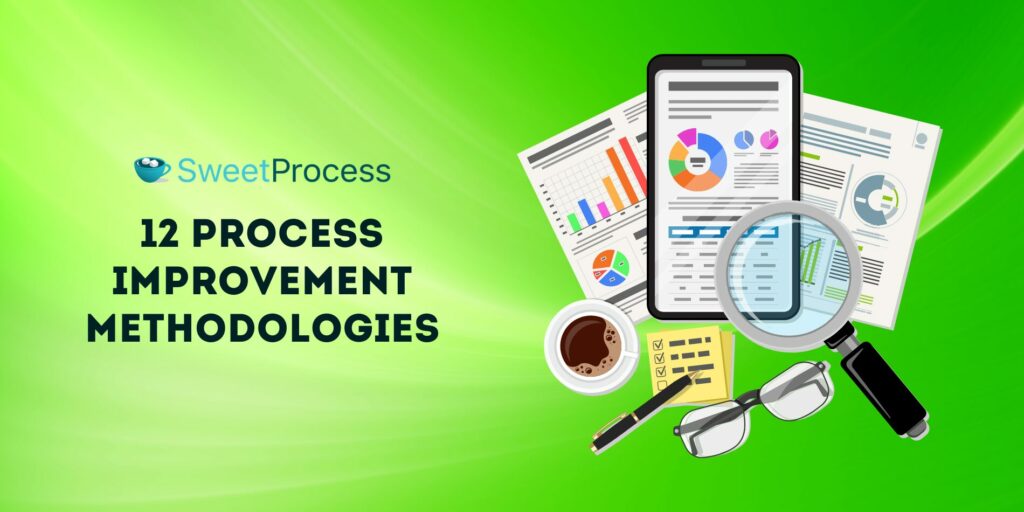
As a business owner, you can implement different process improvement methodologies in your organization. Every methodology has unique strengths that make it applicable to different business scenarios.
Therefore, you need to know which is the best option for your entire company or to just fix problems in some areas of your process. Let’s take a closer look at these methodologies:
PDCA Cycle (Plan, Do, Check, Act)
The PDCA cycle is a four-step approach for continuous improvement. This cyclic approach helps businesses test small changes, measure their effectiveness, and implement improvements systematically.
Here’s how it works:
- Plan: Identify a problem and create an improvement plan.
- Do: Implement the plan on a small scale, maybe one department.
- Check: Measure and analyze your results to see if it worked.
- Act: If successful, implement the change organization-wide; if not, revise and try again.
For instance, a PDCA cycle can be implemented for a restaurant with several locations to test a new system in one branch. If the new process is successful, the management can expand the new system to other locations.
Kaizen
As mentioned, Kaizen is focused on small, incremental changes that lead to significant long-term improvements. It aims to create a culture of continuous improvement involving all employees.
With this methodology, your business can eliminate waste and boost productivity. Teams are encouraged to identify inefficiencies and propose solutions, which are then implemented and refined over time. If problems arise, improvements can be made as soon as possible.
Total Quality Management (TQM)
Customers are always looking for quality. If the quality of your products and services drops, it affects your sales and retention rates. Most businesses mostly focus on only one area of the business that is affecting the quality control, which is ineffective.
However, implementing total quality management (TQM) ensures that every aspect of your organization is operating at a high level, from production to customer service. This approach encourages excellence across all your business functions.
Theory of Constraints
Do you know what is causing a bottleneck in your operations? Maybe you have issues with your suppliers, inventory, machinery, or employees. The theory of constraints identifies, eliminates, and optimizes these bottlenecks across the entire business to ensure every process flows smoothly.
Once you know the problem, you can allocate resources and make the necessary changes before moving on to the next issue. This methodology targets the organization’s critical weak points to keep it efficient.
5S
While the 5S method was initially used in manufacturing, it has become a popular process improvement method in other sectors to improve productivity and safety. It’s built on these five principles:
- Sort: You should only keep important items and remove the unnecessary ones.
- Set in Order: Arrange the important items in their designated place so employees can find them.
- Shine: Keep the workplace clean and tidy, ready for use.
- Standardize: All jobs should be implemented in the same order.
- Sustain: Ensure everyone is responsible for the 5S at all times and keep the practice alive.
Following this standard reduces workplace hazards and maintains a productive work environment.
SIPOC Analysis
This SIPOC analysis process improvement technique helps you map the inputs and outputs of your business process. You can understand the components and every individual involved at every stage.
SIPOC stands for:
- Suppliers: This is the internal or external provider that provides the inputs.
- Inputs: What goes into the process? These inputs include all components involved in the process, including personnel, raw materials, and resources.
- Process: Steps involved in transforming your inputs to outputs.
- Outputs: The results of the process could be services or products.
- Customers: The individuals who receive the final output.
The SIPOC analysis helps identify inefficiencies and gaps at every stage of the process.
Kanban
Have you ever noticed that your campaigns or projects always get stuck at one point? The Kanban methodology uses boards and cards to track tasks and monitor progress.
This work management system visualizes issues so you and your team can implement business improvement processes in these areas. Kanban boards are effective, especially if your team prefers visualization to monitor ongoing and upcoming tasks. The Kanban methodology is ideal for better workload management.
Value Stream Mapping (VSM)
Value stream mapping evaluates the current company process and proposes a future alternative that streamlines operations and minimizes waste. For instance, a manufacturing company can use VSM to identify waste and inefficiencies in its production process, such as excessive inventory, long wait times, and unnecessary transportation.
With this information, you can identify all the valuable and non-value-adding processes and implement the necessary changes.
Six Sigma
Six Sigma is a process improvement methodology that uses data to reduce defects in your processes. Most businesses implement this framework because it relies on vital insights. As a business, you can continuously apply all the variations of your process until you achieve your target results.
Business Process Automation (BPA)
Business process automation is a popular practice in today’s business world. Organizations use technology to automate repetitive tasks, improve efficiency, and reduce errors. Most managers and business owners identify processes that can be automated, such as invoicing or employee onboarding, and adopt software solutions.
BPA frees up time for employees to focus on strategic initiatives.
Cause-and-Effect Analysis
Also known as the fishbone diagram, the cause-and-effect analysis methodology identifies the root causes of problems so that you can implement effective solutions. Teams brainstorm possible causes for a problem and categorize them into areas like people, processes, or equipment.
You can use this technique if you are looking for a structured approach to diagnosing and solving problems.
Process Mapping
Process mapping visualizes your company workflows to identify inefficiencies and opportunities for improvement. To implement this, you’ll create a step-by-step diagram of a process detailing each activity, decision point, and participant.
For instance, in a healthcare facility, you can map your patient intake process, identifying bottlenecks that delay appointments, and what influences wait times. Process mapping breaks down complex processes, making it easier to improve weak areas.
10 Drawbacks of Process Improvement to Avoid

Although most business owners intend to improve their processes regularly, this is not always the case. Several issues can undermine these efforts if not addressed. Let’s look at the common drawbacks of process improvement that organizations should avoid, along with actionable insights to navigate them.
Details Before Context
It’s common for managers to spend more time focusing on the minute details instead of the broader picture. For instance, optimizing individual steps in a customer service process without addressing the root cause of delays—such as understaffing—can lead to short-term fixes that fail to solve the actual problem.
You risk wasting time and resources on irrelevant changes.
Artifacts Over Process
While documentation is important, it should be a byproduct of process improvement, not the primary focus. For example, you might spend more time paying for tools to create detailed flowcharts and reports than on actual process improvement. This approach doesn’t add value and slows down your team.
No Case for Action
Why initiate change without a compelling reason? Starting a process improvement without a clear justification can lead to wasted resources and employee resistance. For instance, altering a well-functioning system without considering the benefits can confuse. Before implementing any changes, communicate the rationale so everyone understands why the initiative is necessary.
Lack of Employee Engagement
Employee buy-in is critical for successful process improvement. Excluding your team members from the improvement process could result in poor adoption. They might not cooperate and adopt the new workflows meant to improve product and service quality. You should engage your employees from the brainstorming session to implementation.
Lack of Understanding
Does your team fully grasp what’s changing and why? When employees don’t understand the goals or methods of process improvement, they might misinterpret their roles or resist changes. For instance, if team members misinterpret the purpose of a new protocol, they may apply it incorrectly, leading to inefficiencies. To align the entire team, provide clear explanations and training sessions.
Failure to Define Terminology
You must have encountered terms that are difficult to interpret at one time. Having the same in your company will confuse process improvement initiatives. Using ambiguous words or jargon without explaining specific actions or outcomes will lead to misalignment. It’s important to define all terms used in the process improvement plan so that every employee understands them.
Over-Optimization
Once you identify a bottleneck in your process, you must find a balance to avoid excessive optimization. A good example is if you reduce the steps in a customer service workflow to save time but compromise on the quality of service. Your optimization plan should factor in all parts of your process to ensure you don’t reduce the quality of your overall operations.
Poor Communication
Are communication gaps negatively impacting your improvement efforts? Failing to communicate changes during process improvement can lead to confusion and errors. For example, if some company departments aren’t informed about updated compliance procedures, they might continue using outdated methods.
Solving the Problem Too Quickly
Some managers spot problems and rush to fix them quickly without analyzing the root cause. This approach is costly for your business because you might end up with short-term solutions that fail in the long run. It’s better to examine all the underlying issues to make process improvement sustainable.
Not Taking Action
Once you identify gaps in your process, what’s your next step? Do you keep the plans in a document without implementing them? Analyzing processes without taking action will cause stagnation and lead to losing your competitive edge. Failing to execute your strategy limits your company’s capabilities.
Improve Your Company’s Processes Using SweetProcess

Process improvement is a mindset that empowers businesses to operate more efficiently. To stand out in today’s business environment, you need to identify your efficiencies and implement a culture of continuous improvement in all departments.
Once you identify a process improvement methodology that aligns with your business, you can start streamlining your workflows.
And what better way to achieve this than by adopting the right business tools? SweetProcess offers a powerful and intuitive platform to document, manage, and optimize workflows. Whether you’re creating standard operating procedures or streamlining complex processes, SweetProcess helps you ensure consistency, clarity, and measurable results.
Ready to transform your business? Sign up for a free trial of SweetProcess today and start building the efficient, productive organization you’ve always envisioned! No credit card is required!

